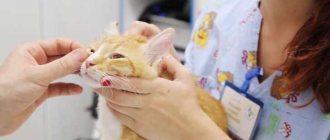Feline calcivirosis is an acute infection, in severe cases leading to the death of the patient. It is not transmitted to other pets and humans, but in cats it causes inflammation of the conjunctiva of the eyes, the oral mucosa, spreading to the respiratory organs. Antiviral vaccination, as well as timely, properly selected treatment contribute to an almost complete cure.
Description of the ailment
The disease is caused by the pathogenic microorganism Feline calicivirus (FCV). It is distributed throughout the world, including in Russia. There are more than 40 types of dangerous strains, differing from each other in symptoms and severity. Like the flu virus, the bacterium is capable of being variable and mutating into a more dangerous form. The disease has another international name - calcivirus.
Immunologists note that the virus is resistant to high temperatures and persists in a humid environment. For example, in a dry atmosphere it remains active for up to 3 days, but in a slushy environment or snow cover its survival increases to 12 days.
Methods and probability of infection
Viral pathology affects the respiratory tract and mucous membranes. Kittens from one month of age, as well as adults with weakened immune systems, can get sick. Residents of shelters or nurseries often suffer due to crowded housing and unsanitary conditions that contribute to the spread of infection.
Symptoms appear suddenly, the active phase lasts from 7 to 25 days. After this, the pet’s recovery occurs in the case of correctly selected drug therapy. The likelihood of death of an unvaccinated cat depends entirely on the length of time between the appearance of the first signs and the start of treatment. The shorter the time period, the more favorable the prognosis for a complete cure of the patient. Autumn and winter are the most favorable periods for the spread of the disease.
Can a person become infected?
Feline calcivirus is not dangerous for its owner or other four-legged animals. But other representatives of the cat family are at risk. Moreover, both wild and domestic individuals are at risk.
It is worth remembering that a person, although not susceptible to calcivirus, may well be its carrier. There are cases when the virus was transmitted from one animal to another without direct contact: through human clothing and shoes, unwashed hands, etc. Therefore, disinfection of the room and clothing of the person caring for a sick cat is mandatory.
Prevention
The only reliable way to prevent calcivirus infection in cats is vaccination. Veterinarians include vaccination against this disease in the standard vaccination regimen. The vaccine does not completely protect a cat from infection with calcivirus, since there are many varieties of it. But the presence of immunity makes it easier to endure the infection and avoid complications. The likelihood of infection is also reduced. Vaccinations begin for kittens from 8 to 12 weeks of age. The vaccine is administered two or three times. Afterwards, revaccinations are done every 1-3 years. Vaccines contain different numbers of strains. There is no biological product that can protect cats from all types of calcivirus. Complex vaccines are used for vaccination.
- Nobivac Ducat. Intervet , Holland. Live dry vaccine against viral rhinotracheitis and feline calicivirus. Initially, they are vaccinated twice with an interval of 3–4 weeks. Immunity is developed 10 days after the second administration, its duration is 12 months. Nobivac Ducat can be used from 6 weeks of age.
- Nobivac Tricat . Vaccine against calicivirus, viral rhinotracheitis and feline panleukopenia live dry. The characteristics of the drug are similar to the previous vaccine, but it can only be used from 8 weeks of age.
- Multifel-4. NPO "Narvak" , Russia. Inactivated (killed) vaccine against panleukopenia, rhinotracheitis, calicivirus and feline chlamydia. Kittens are vaccinated at the age of 8 – 12 weeks. The vaccine is administered twice with an interval of 21–28 days. Revaccinate once at the age of 10-12 months. Then the vaccination is repeated once a year. Immunity is developed 14 days after the second injection of the vaccine, the duration of protection is 12 months.
- Vaccines of the "Purevax" . Merial , France. Trivalent "Purevax RCP" and tetravalent "Purevax RCPCh" (against panleukopenia, infectious rhinotracheitis, calicivirus infection and feline chlamydia). Contains an inactivated calcivirus component. Immunity to calcivirus infection is developed 14 days after the second injection of the vaccine, for a period of one year.
Only healthy animals can be vaccinated. Before vaccination, deworming is carried out. Before mating, it is recommended to vaccinate the cat 3–4 weeks in advance to ensure a high level of maternal antibodies in future offspring. Pregnant cats cannot be vaccinated. In addition to vaccination, they follow the general rules for the prevention of infectious diseases.
- Complete feeding.
- Housing hygiene: regular wet cleaning (in case of group housing - regular disinfection), compliance with zoohygienic air parameters (ventilation, temperature, humidity).
- In group housing, newly arrived animals are kept separately for 10-14 days (quarantine).
- The cat owner is not recommended to visit homes where there are sick pets. If this is not possible, then after returning they change clothes, wash their hands thoroughly with soap, and do not allow the cat to come into contact with outdoor clothing and shoes.
Calcivirus infection in most cases ends safely. The disease is more difficult for small kittens and weakened animals. In any case, at the first signs of infection - sneezing, runny nose, drooling, refusal to feed - the cat should be shown to a veterinarian. He will prescribe treatment, which is usually carried out at home. To protect your cat from calcivirus infection, it is recommended to get vaccinations on time.
Causes of calcivirosis in cats
Infection occurs in several ways, but the exact route has not been fully established. Scientists can only talk about the factors of microorganism reproduction in the mucous membranes of the oral cavity, conjunctiva, and tissues of the respiratory system.
Infected animals transmit the infection into the environment through secretions from the nose, eyes, or mouth. When you sneeze, the bacteria spreads through the air many meters around. The virus can easily be brought into the house on outer clothing, shoe soles, or dirty hands. Often, infection can be caused by communication between a pet and a selected street cat, which has become a carrier of a dangerous pathogen.
The main methods of transmission of calcivirus include:
- direct contact with an infected cat;
- airborne droplets;
- through cat household items: bowl, tray, toys.
Most often, penetration occurs through inhalation through the mouth or nose; less often, the pathogen is transmitted through the excrement of the carrier. Unfortunately, often the owner does not know whether the pet has a pathogenic microorganism. In this regard, the risk of spreading the infection increases when he visits public places, walks in public with other cats, or during mating. When an infected animal lives in the same place with other baleen animals, the use of one bowl for all animals is sufficient for infection.
The pathogen does not persist outside the body of the individual for a very long period of time. Thus, the maximum survival period is about 18 days. This must be taken into account when choosing a new cat to replace one that died from the disease.
Candidiasis
A systemic drug for the treatment of candidiasis.
A whitish coating appears on the tongue, inflammation develops, the mucous membrane melts, and ulcers form.
The disease is caused by permanent inhabitants of the cat's mouth - yeast fungi, the development of which is facilitated by the following factors:
- Long-term treatment with antibiotics destroys yeast's competitors - bacteria.
- Uncontrolled use of steroidal anti-inflammatory drugs suppresses the immune system.
- Diabetes mellitus weakens the protective properties of the mucous membranes.
- When feeding cereals, excess starch occurs, which promotes the proliferation of yeast.
Be sure to read:
What is the reason and what to do if a cat’s claws peel off?
Additional signs are dermatitis with skin rashes, damage to the claws. Treatment consists of eliminating the underlying disease, diet therapy, and the use of external and systemic antifungal drugs.
Signs of calcivirosis in cats
Like other viral infections, in adult cats and kittens, calcivirosis begins its manifestations with a depressed general condition, discharge of fluid from the nose, eyes, and lack of appetite. Hyperthermia, associated with an increase in body temperature, is detected on the 3-4th day, but in 2-3-month-old kittens it manifests itself immediately. Vomiting can be multiple or single, but sometimes it is completely absent.
This clinical picture is characteristic of most bacterial diseases, so diagnosing the disease at this stage is quite difficult. Because of this, it is possible to miss the initial stage of development of a dangerous strain, which leads to an advanced form of illness with all the ensuing complications and consequences.
For example, in a domestic cat that spends a lot of time outside, the listed symptoms are often attributed to poisoning from selected food or an infectious rodent.
Acute calcivirosis
The acute form involves the manifestation of characteristic symptoms immediately after infection. This course of the disease is frightening, but it allows for a more accurate diagnosis. Even an experienced cat breeder without the help of a veterinarian will be able to recognize calcivirosis if he has already encountered it. However, this does not mean that you should postpone a visit to the doctor - on the contrary, you need to go to the clinic as soon as possible.
The most characteristic sign is considered to be small ulcers on the lips, nose, palate, and tongue. At first they are sporadic, and near the nose can be explained by cold discharge. Therefore, diagnosis based on this symptom is one of the most accurate.
The owner may notice that the cat is hungry and asks for food, but when starting a meal, he immediately refuses it. The animal greedily sniffs the treats, but cannot take them into its mouth, since the ulcers are very painful and interfere with eating. In severe cases, the sick person may refuse water: then he will have to pour in slightly warmed water through a syringe without a needle.
The next stage is difficulty breathing and complications in the form of viral pneumonia. Sometimes there is an impact on the pet’s musculoskeletal system, resulting in arthritis.
Warning signs for the spread of the disease:
- unexplained refusal to eat;
- increase in animal body temperature;
- heavy, rapid breathing;
- a feeling that the pet wants to push something out of the mouth.
It happens that the body partially resists the virus, and it proceeds slowly and with vague symptoms. Then we are talking about the chronic form.
Chronic calcivirosis
This form is more dangerous because it can be easily confused with other diseases: for example, poisoning or heat stroke. The cat becomes lethargic, eats and drinks little, and mouth ulcers appear in isolated cases.
As soon as the exacerbation phase begins, everything falls into place: the veterinarian makes a preliminary diagnosis without tests. But, unfortunately, if chronic calcivirosis worsens, it may be too late: the animal is exhausted, and even intensive treatment does not always help.
The course of calcivirosis in a kitten
Doctors note that kittens under 3 months of age have less chance of recovery than adults. The fact is that the virus manifests itself suddenly and very strongly: the baby’s temperature rises sharply, discharge from the eyes and nose appears, profuse salivation, inflammation of the oral cavity, which quickly spreads to the larynx. Due to malaise and pain, the kitten refuses food and water, so death in a fragile organism can occur 2-4 days after the onset of the disease.
If you notice even one sign of calcivirosis in a kitten, urgently take it to the veterinary clinic. Doctors will take a whole range of measures to save him:
- will introduce serum of the required dosage;
- they will give you an antibiotic;
- they will puncture an IV if the kitten is dehydrated and exhausted, and prescribe vitamins in the form of injections;
- They will administer a strong painkiller to ease the baby’s suffering.
At home you need to give the kitten maximum attention and care. It is necessary to give injections several times a day and lubricate the little patient’s oral cavity with products prescribed by the doctor. If the kitten’s body is strong, and treatment is started on time and carried out intensively, its condition will improve within a few days. The baby will begin to eat, drink and even play on his own.
Symptoms
One of the signs of calcivirosis is a thick yellow and purulent discharge from the eyes.
The following symptoms are typical for a pet infected with calcivirus:
- Increased temperature and general malaise of the pet;
- The formation of ulcers in the oral cavity, in particular on the lips, tongue, hard palate, also on the nostrils, mainly on their middle fissure;
- Shortness of breath, difficulty breathing, which indicates lung damage;
- Purulent discharge from the sinuses, lacrimation;
- Disorientation in space, convulsions, lameness;
- Oppressive odor from the mouth;
- Diarrhea, vomiting.
Diagnosis by a veterinarian
If the owner notices the warning signs described above, then it is time for an emergency visit to the veterinary clinic. At a doctor's appointment, you need to answer questions about the presence or absence of a pathological desire in your pet to inhale chemicals and washing powder. It is necessary to find out whether he chewed toxic house plants, for example, Kalanchoe, aloe. Explain what was included in the last feeding and what the pet has been doing over the past 24 hours.
The veterinarian may also ask leading questions that may not seem entirely meaningful to the patient’s owner. Most likely, the doctor will ask whether there is air conditioning in the house, when and with what the pet was last bathed. Thanks to questioning, a general picture of the disease emerges, which helps to make the correct diagnosis.
The veterinarian prescribes a PCR test to determine the presence of the virus in the animal’s DNA. Repeated studies are often performed, especially if the results are negative but the symptoms do not subside. If it is not possible to conduct such an analysis, the disease is determined by the clinical picture.
Treatment of the disease
How to treat calcivirus in cats? Therapy must begin with a correct diagnosis. Without this, treatment cannot be started, because each infection has its own pathogen, which requires specific treatment. So, for calcivirus, it is necessary to prescribe a special hyperimmune serum that contains antibodies to the pathogenic microorganism.
However, if the disease is uncertain, a multicomponent serum should be immediately administered against three viral ailments: panleukopenia, calicivirus, and rhinotracheitis.
If the pet does not eat for a long time or has vomiting, frequent loose stools, or an elevated body temperature, then it is important to place IVs and inject subcutaneous saline solutions of sodium chloride, glucose, and Ringer-Locke. They are used 20-50 ml every 6-12 hours. It should be taken into account that no more than 20 ml of saline solution can be injected under the skin into one place.
It is good to alternate injections and droppers with each other when treating calcivirosis in cats. In the morning you can use sodium chloride, and in the afternoon you can introduce a glucose solution, then again a saline solution, and then glucose. A glucose solution removes intoxication well, promotes the removal of toxins, and a sodium chloride solution helps restore the water-salt balance that occurs due to dehydration. Such alternations help avoid further death of body cells.
After the cat’s body has become sufficiently strong as a result of drug therapy, a therapeutic diet is necessary. Probiotics, that is, drugs that restore intestinal microflora, are introduced into the menu as prescribed by a veterinarian.
Medicines to treat an infected person:
- antibiotics that prevent the development of inflammation and pneumonia;
- vitamin and mineral complexes that strengthen and restore the strength of the convalescent;
- means that speed up metabolism and completely remove intoxication from the body;
- symptomatic treatment that supports the cardiac, respiratory, and digestive systems in a healthy state.
Mostly, medications are administered by injection, since the animal’s oral cavity is very sensitive due to ulcers. Tablets and liquid preparations will only increase the pain of the furry sufferer. Therefore, you will have to learn how to give injections yourself or invite a visiting nurse.
Features of treating a pregnant cat
Unfortunately, doctors are rarely able to save the offspring of a sick female. This is due to the fact that the body devotes all its strength to protecting the mother cat, and the fetus is practically defenseless. A specialist selects the appropriate treatment based on many factors: gestational age, number of fetuses, severity of the disease, etc. The owner’s task is to show the pet to the doctor on time and devote enough time to its treatment.
Features of kitten treatment
It is necessary to start therapy on the very first day the first symptoms appear, otherwise the chances of recovery are greatly reduced. The doctor prescribes a small patient a whole range of therapeutic measures, which include injections, rinsing and lubricating the mouth with medications, and a therapeutic diet. In some cases, hospital treatment may be required.
The main difficulty in treating children is choosing the dosage. Often a microscopic dose of a particular drug is required, and only a doctor can determine it. You cannot do this on your own - it will only harm the kitten.
The main rule for kittens less than six months old is to carry out a full course of treatment. If you complete the course recommended by the doctor a day or two earlier, the disease may return, with a vengeance and unpleasant consequences. It is optimal if the therapy ends after a complete examination of the patient at the veterinary clinic and the doctor confirms that the baby is healthy.
Aftercare
It should be remembered that after the final recovery, the pet will not be safe. Immunity is restored only within six months, but the danger of transmitting the virus remains.
Calcivirosis is considered one of the most serious diseases for felines, so it is worth taking care of the complete comfort of your pet. If there are other cats living at home, it is advisable to separate them from the sick person for a while. Be sure to check other cats for the presence of the virus by taking tests. If they are healthy, then it is necessary to vaccinate, and after quarantine and complete recovery of the patient, the animals can be placed together again.
Provide your cat with a comfortable bed or allocate a place on the sofa, chair, or bed. Try to stay nearby all the time.
Be sure to make sure that the water in the bowl is clean and warm: ulcers make it painful to drink liquid at room temperature. The food should be soft, puree-like: depending on the cat’s preferences, buy him pate or boil and chop lean meat (chicken, turkey, rabbit). The menu can be adjusted with the help of a veterinarian: he will recommend therapeutic nutrition and also prescribe the necessary vitamins and supplements. Some of them will have to be given in the form of injections.
Consequences of calcivirosis in cats
After completing a course of medication, the recovered pet acquires specific immunity to the pathogen. Re-infection is extremely rare, but it is premature to talk about stable immunity in those who have recovered from the disease.
Is the cat still a carrier of calcivirus?
Often the cat does not show any visible symptoms after suffering from an illness. The owner should remember that an apparently healthy pet can be very contagious to other relatives.
Research by scientists from the UK has confirmed that during the first month after the cessation of the disease, all former patients remain active carriers of the bacterium. During this time period, it is necessary to avoid visiting places where there are unvaccinated or young individuals under 1 year of age. It is not recommended to invite guests who have mustachioed pets into the house so that they cannot spread the infection on outer clothing, shoes or hands.
Over time, the transmission activity of the pathogenic microorganism decreases greatly. So, after two and a half months, only about 50% of recovered animals remain carriers. Unfortunately, there are individuals with a very weakened immune system who continue to remain a carrier of the infection for life.
It is quite simple to identify a cat carrying the virus: it still has problems with the oral cavity. They are expressed in a very unpleasant odor, periodic stomatitis or gingivitis. Any redness in the mouth and excessive salivation should alert the owner. In a cat that has had calcivirus within the last year, this becomes the reason for a trip to the veterinary clinic.
Owner Irina:
My cat suffered from calcivirus at a young age. Now the person who has recovered from the disease is left with bad breath and the fear of going hungry (he could not eat during his illness). But overall, this is an absolutely healthy cat - so don’t waste your time and energy! Calcivirosis is treatable, and you can do without terrible consequences.
Prognosis for recovery
The prognosis is favorable if we are talking about an adult and timely initiation of treatment. In small kittens and very elderly animals, it is more difficult to make predictions: it all depends on the body’s resistance. The veterinarian will definitely warn you that death is possible, but with proper care and intensive treatment it is reduced to almost zero.
Repeat tests for complications
Many veterinarians tend to believe that calcivirosis and its treatment place a heavy burden on the kidneys and lead to early chronic renal failure (CRF). Research is currently underway in this regard. At risk are animals that have suffered a severe case of calcivirus, as well as kittens that were ill at a young age.
The virus can cause complications in other body systems: the gastrointestinal tract, liver, lungs and trachea. Many disorders occur latently for several years, and then make themselves felt in the final stage, when treatment comes down to maintaining a decent standard of living - and nothing more.
To prevent dangerous consequences, it is important to donate blood after the animal is completely cured after 6-8 months for general and biochemical analysis. If any organ is damaged as a result of a severe course of the calcivirus, tests will show this. The owner will be able to begin timely treatment.
How much danger is there for the other cats living in the house?
It is believed that a sick cat begins to massively release the pathogen into the external environment approximately three weeks from the moment of infection. As we have already said, pets that are carriers of the infection constantly spread the virus in the external environment, despite the time that has passed since “recovery.” If they come into contact with young cats or kittens, the probability of getting sick for the latter is close to 100%. In the case when your pet is vaccinated and more than three weeks have passed since vaccination, the entry of the pathogen into its body either passes without consequences, or a disease develops, but it proceeds in the mildest possible form. But does everything depend on vaccination?
For example, can a cat who has already had calcivirus get sick again? We have already answered this question earlier. If everything is in order with the animal’s immunity and nutrition, then no. Antibodies present in the blood of a convalescent (recovered) person will reliably protect him from relapse. If the cat is old, malnourished, or recovering from a severe infection, the likelihood of recurrence of the disease increases. True, repeated pathology will almost certainly be much easier, the likelihood of severe consequences is very low.











